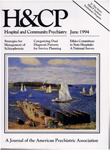The Zung Self-Rating Depression Scale as a Potential Screening Tool for Use With Eskimos
Abstract
Objective: The study assessed the utility of a modified Zung SelfRated Depression Scale (SDS) in detecting major depression among Eskimo patients in the Bering Straits region of Alaska. Methods: The modified SDS was administered to Eskimo patients referred for psychiatric evaluation at the community mental health center in Nome. Diagnoses were assigned by a staff psychiatrist based on DSM-III-R criteria. The SDS scores of 25 consecutive patients with a diagnosis of major depression were compared with the scores of 25 consecutive patients assigned other psychiatric diagnoses. Results: The modified SDS was readily understood by patients and took between three and four minutes to complete. The mean SDS score of patients with a diagnosis of major depression was significantly different from that of patients with other diagnoses. The SDS had a sensitivity of 80 percent and specificity of 88 percent for detecting patients with major depression. Conclusions: The SDS is easy to administer and can differentiate between patients with major depression and those with other psychiatric diagnoses. it can be modified to fit local idiom in an Eskimo community. The SDS shows promise as a clinically relevant screening tool for major depression in populations with limited access to psychiatric care.
Access content
To read the fulltext, please use one of the options below to sign in or purchase access.- Personal login
- Institutional Login
- Sign in via OpenAthens
- Register for access
-
Please login/register if you wish to pair your device and check access availability.
Not a subscriber?
PsychiatryOnline subscription options offer access to the DSM-5 library, books, journals, CME, and patient resources. This all-in-one virtual library provides psychiatrists and mental health professionals with key resources for diagnosis, treatment, research, and professional development.
Need more help? PsychiatryOnline Customer Service may be reached by emailing [email protected] or by calling 800-368-5777 (in the U.S.) or 703-907-7322 (outside the U.S.).



